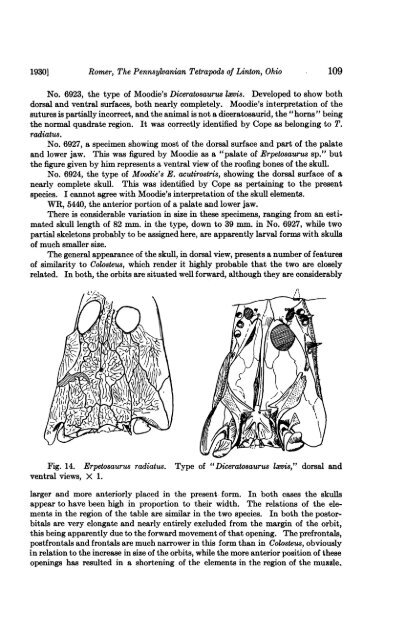View/Open - American Museum of Natural History
View/Open - American Museum of Natural History
View/Open - American Museum of Natural History
Create successful ePaper yourself
Turn your PDF publications into a flip-book with our unique Google optimized e-Paper software.
19301 Romer, The Pennsylvanian Tetrapods <strong>of</strong> Linton, Ohio<br />
109<br />
No. 6923, the type <strong>of</strong> Moodie's Diceratosaurus levis. Developed to show both<br />
dorsal and ventral surfaces, both nearly completely. Moodie's interpretation <strong>of</strong> the<br />
sutures is partially incorrect, and the animal is not a diceratosaurid, the "horns" being<br />
the normal quadrate region. It was correctly identified by Cope as belonging to T.<br />
radiatus.<br />
No. 6927, a specimen showing most <strong>of</strong> the dorsal surface and part <strong>of</strong> the palate<br />
and lower jaw. This was figured by Moodie as a "palate <strong>of</strong> Erpetosaurus sp." but<br />
the figure given by him represents a ventral view <strong>of</strong> the ro<strong>of</strong>ing bones <strong>of</strong> the skull.<br />
No. 6924, the type <strong>of</strong> Moodie's E. acutirostris, showing the dorsal surface <strong>of</strong> a<br />
nearly complete skull. This was identified by Cope as pertaining to the present<br />
species. I cannot agree with Moodie's interpretation <strong>of</strong> the skull elements.<br />
WR, 5440, the anterior portion <strong>of</strong> a palate and lower jaw.<br />
There is considerable variation in size in these specimens, ranging from an estimated<br />
skull length <strong>of</strong> 82 mm. in the type, down to 39 mm. in No. 6927, while two<br />
partial skeletons probably to be assigned here, are apparently larval forms with skulls<br />
<strong>of</strong> much smaller size.<br />
The general appearance <strong>of</strong> the skull, in dorsal view, presents a number <strong>of</strong> features<br />
<strong>of</strong> similarity to Colosteus, which render it highly probable that the two are closely<br />
related. In both, the orbits are situated well forward, although they are considerably<br />
I,~~~~~~~~~<br />
Fig. 14. Erpetosaurus radiatus. Type <strong>of</strong> "Dicerato8aurus 1evis," dorsal and<br />
ventral views, X 1.<br />
larger and more anteriorly placed in the present form. In both cases the skulls<br />
appear to have been high in proportion to their width. The relations <strong>of</strong> the elements<br />
in the region <strong>of</strong> the table are similar in the two species. In both the postorbitals<br />
are very elongate and nearly entirely excluded from the margin <strong>of</strong> the orbit,<br />
this being apparently due to the forward movement <strong>of</strong> that opening. The prefrontals,<br />
postfrontals and frontals are much narrower in this form than in Colosteus, obviously<br />
in relation to the increase in size <strong>of</strong> the orbits, while the more anterior position <strong>of</strong> these<br />
openings has resulted in a shortening <strong>of</strong> the elements in the region <strong>of</strong> the muzzle.
















